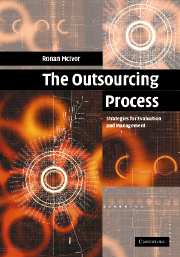Book contents
- Frontmatter
- Contents
- List of figures
- List of tables
- List of illustrations
- Acknowledgements
- 1 Introduction
- 2 The trend towards outsourcing
- 3 Theoretical influences on outsourcing
- 4 The outsourcing process: a framework for evaluation and management
- 5 Determining the current boundary of the organisation
- 6 Activity importance analysis
- 7 Capability analysis
- 8 An analysis of the strategic sourcing options
- 9 Developing the relationship strategy
- 10 Establish, manage and evaluate the relationship
- 11 Case study – outsourcing experiences at Telco
- 12 Conclusions
- Index
- References
8 - An analysis of the strategic sourcing options
Published online by Cambridge University Press: 21 August 2009
- Frontmatter
- Contents
- List of figures
- List of tables
- List of illustrations
- Acknowledgements
- 1 Introduction
- 2 The trend towards outsourcing
- 3 Theoretical influences on outsourcing
- 4 The outsourcing process: a framework for evaluation and management
- 5 Determining the current boundary of the organisation
- 6 Activity importance analysis
- 7 Capability analysis
- 8 An analysis of the strategic sourcing options
- 9 Developing the relationship strategy
- 10 Establish, manage and evaluate the relationship
- 11 Case study – outsourcing experiences at Telco
- 12 Conclusions
- Index
- References
Summary
Introduction
The preceding analysis considered the dimensions of activity importance and organisational capability in the context of outsourcing. These two dimensions yield a number of strategic sourcing options as shown on the matrix in Figure 8.1. This chapter is concerned with evaluating the implications of each of these potential strategic sourcing options. These options should be considered in the context of the following key determinants.
The disparity in performance – this is concerned with determining the sustainability of superior performance in an activity – either by the internal or external source. Some of the insights gained from the capability analysis will assist at this stage. Having a clear understanding of the source of superior performance can provide a reliable indication of the sustainability of such a position. For example, if the company's capabilities lag considerably behind the capabilities of external suppliers, then it may be difficult to justify a substantial investment of resources in order to match or advance upon the capabilities of these external suppliers.
Technology influences – this is concerned with understanding the influence of technology on the choice of sourcing option. For example, if the environment is characterised by rapid advances in technology then any performance advantages the organisation possesses may be difficult to sustain over a long period of time.
External considerations – factors in the external environment such as the political context, market growth rates, the level of competition and barriers to entry should also be considered. For example, in an industry characterised by high levels of growth and competitive rivalry, competitors can rapidly erode a superior performance advantage in an activity.
[…]
- Type
- Chapter
- Information
- The Outsourcing ProcessStrategies for Evaluation and Management, pp. 183 - 217Publisher: Cambridge University PressPrint publication year: 2005



